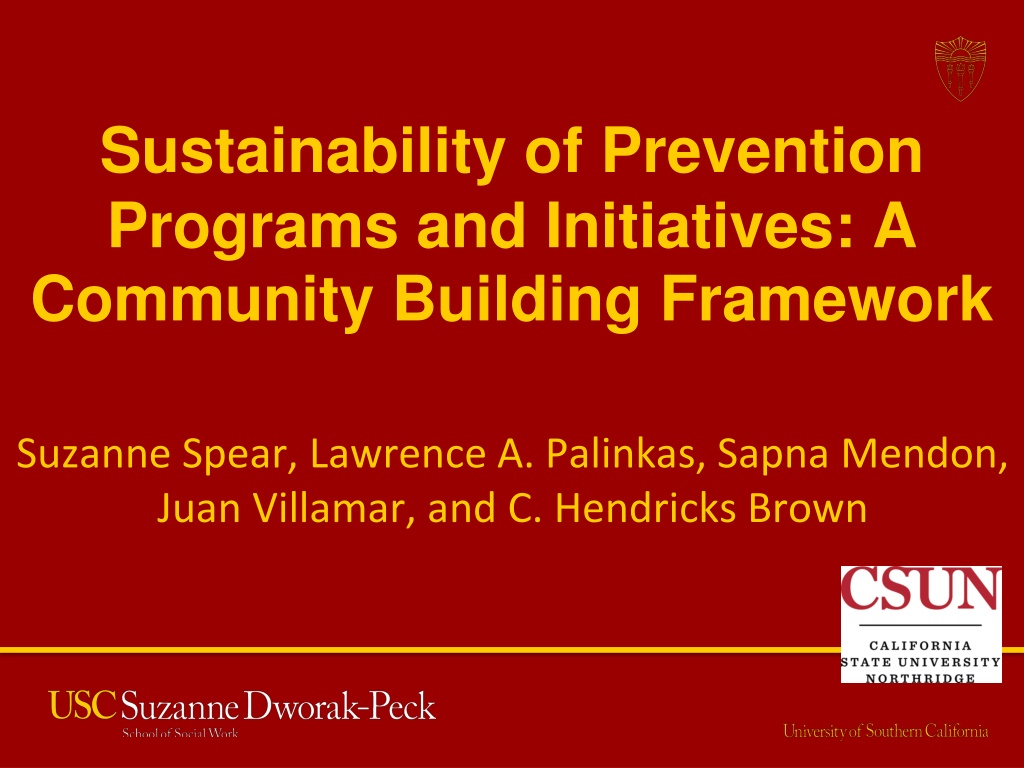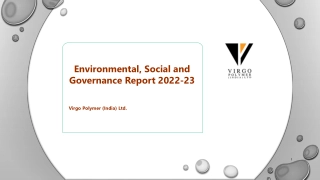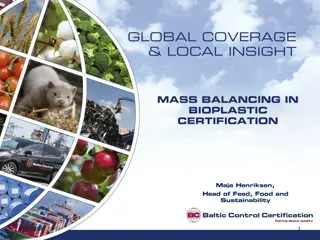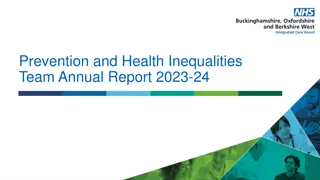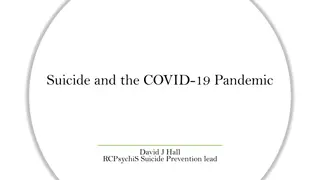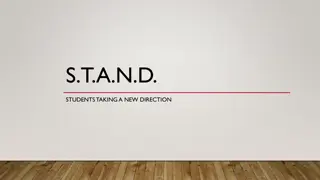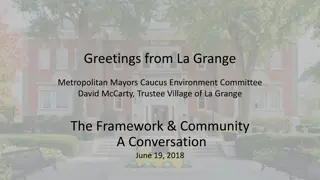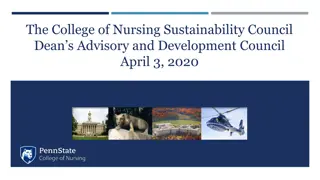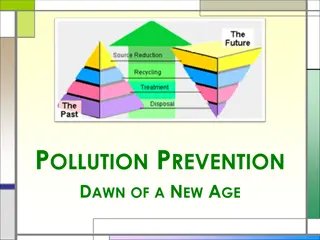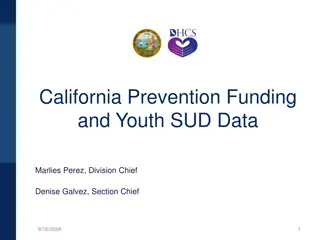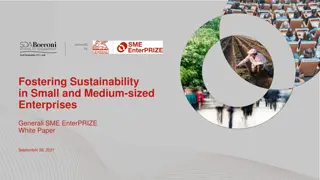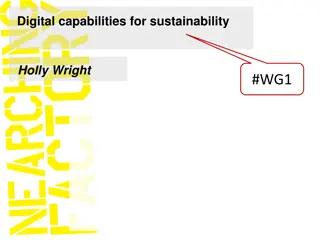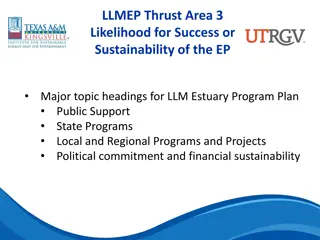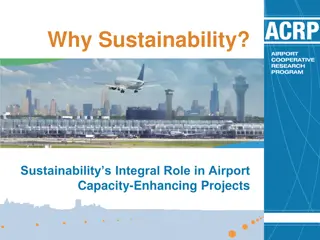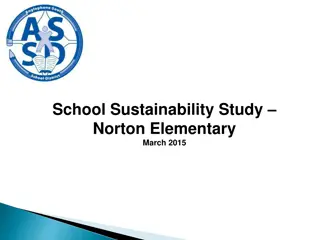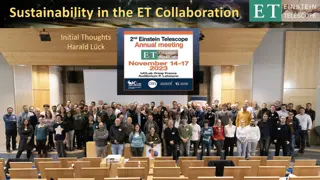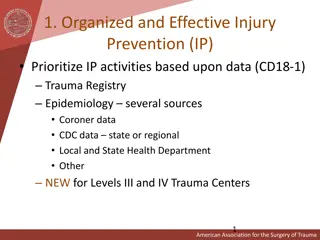Sustainability of Prevention Programs and Initiatives: Community Building Framework
This study explores the sustainability of prevention programs and initiatives through a community building framework. It delves into identifying core components and interrelationships for the sustainment of prevention programs. The research also discusses various programs like Strategic Prevention Framework State Initiative Program, Drug-Free Communities Support Program, and more.
Download Presentation

Please find below an Image/Link to download the presentation.
The content on the website is provided AS IS for your information and personal use only. It may not be sold, licensed, or shared on other websites without obtaining consent from the author. Download presentation by click this link. If you encounter any issues during the download, it is possible that the publisher has removed the file from their server.
E N D
Presentation Transcript
Sustainability of Prevention Programs and Initiatives: A Community Building Framework Suzanne Spear, Lawrence A. Palinkas, Sapna Mendon, Juan Villamar, and C. Hendricks Brown
Acknowledgements Grants: NIDA R34DA037516 & NIDA P30DA027828 2
Acknowledgements Center Dir. Frances Harding, CSAP Center for Substance Abuse Prevention (CSAP) Division of Community Programs Division of State Programs Center for Mental Health Services (CMHS) Division of Prevention, Traumatic Stress, and Special Programs
Disclaimer The views, opinions and content expressed in this presentation do not necessarily reflect the views, opinions or policies of the Center for Mental Health Services (CMHS), Center for Substance Abuse Prevention (CSAP), the Substance Abuse and Mental Health Services Administration, or the U. S. Department of Health and Human Services (HHS)
Phase 1 of Measuring Sustainment of Prevention Programs & Initiatives Study Aim: Identify core components and their interrelationships across time for sustainment of prevention programs and their support infrastructures
SAMHSA Ce-PIM Partnership Four SAMHSA Prevention Programs: Strategic Prevention Framework State Initiative Program (SPF-SIG) Drug-Free Communities Support Program (DFC)/Sober Truth on Preventing Underage Drinking (STOP Act) Garrett Lee Smith State and Tribal Youth Suicide Prevention (GLS) Implementing Evidence-Based Prevention Practices in Schools (PPS)
Current Conceptual Models of Implementation Originated in health services research field Based on implementation & behavioral theories, e.g., DOI, Theory Planned Behavior Sustainment is understood as final stage in a linear process
Current Conceptual Models of Implementation Main predictors are characteristics of innovations and individual actors (innovation users, champions, trainers) Unit of analysis is an organization, e.g., health clinics Little to no emphasis on communities
Community Coalition Approach to Prevention
Measuring Sustainment of Prevention Programs Study Phase 1 Telephone interviews and site visits with 10 grantees Interviews with 45 key staff. Collection of grant proposals, progress reports, other documents.
Methods Data analysis Analyzed qualitative data (interviews & free lists) Data were coded & organized into common categories/domains Frequency of categories observed for free lists Most common categories on free lists compared with those from the interviews Domains were used to construct a set of broad themes
Theme 1- Thinking Big: Broadening the Lens of Sustainability The focus of all grant programs is the community Goals of SPF-SIG, STOP-ACT, & GLS are broad, e.g., improving prevention systems, coordination of care across providers, and changing social norms Developing relationships & strengthening coalitions just as important for sustainment (and sometimes more important) as interventions
Theme 1- Thinking Big: Broadening the Lens of Sustainability One of the things, one of the outcomes, which is not necessarily an outcome about infrastructure was the Berkshires coalition...That was one of the objectives for that grant, was to actually have the Berkshires develop a self-sustaining suicide prevention coalition. You can almost think of it as a statewide coalition of sorts, because if you don t have that investment by multiple agency partners, you re not going to get it moving, and not going to keep it sustaining, because we all have to talk the same language. (GLS grantee from MASS) behavior, had but about developed a
Theme 2- Improving Prevention through Community Building and Capacity Development Prevention practices and processes are mutually reinforcing. Capacity development (i.e., training & technical assistance, program/coalition coordinator) is critical for changes at community or system level. SAMHSA s planning framework emphasizes the role of infrastructure in improving community health
Theme 2- Improving Prevention through Community Building and Capacity Development If we re doing our job, we don t want them to do the same media campaign for 100 years. So we want to give them the capacity to use data, to pick the appropriate intervention for whatever intervening variable [or] contributing factor I think prevention is going to be stronger. That to me, is what I would hope would be sustained, and that s what I was tasked to do to work with communities to make that happen. (Evaluator for SPF-SIG grant)
Theme 3: Sustainment as Dynamic, Emergent Process Support for sustainment of a particular program or intervention must be actively cultivated by strong leaders within community coalitions and networks (e.g., need buy in ) Outcomes for many programs do not yet exist; hence importance of evaluation Community building can develop a shared consciousness around the importance of programs and initiatives
Theme 3: Sustainment as Dynamic, Emergent Process Suicide prevention expansion requires a shared consciousness or culture of prevention : The Zero Suicide philosophy is that suicide is a thing that is preventable and that we have all have a responsibility to do so and that it s not a tangential service of mental health care but it is a primary service and should be, if nothing else, the first thing we address whenever we work with any client. (GLS grantee TENN)
Community-Building Framework for Sustainment of Prevention Programs Key Principles Community is at the center of practice. Community defined as relations between people & organizations at multiple levels (local, region, state) (Walter, 2006). Community is dynamic, emergent, created and recreated through actions & interactions of people & organizations (Walter, 2006).
Community-Building Framework Key Principles, cont. Goal is to develop capacity of community to identify, mobilize & address social and public health problems (Goodman et al., 1998) Programs should incorporate & build upon community strengths (Wallerstein et al., 2015) Process & outcomes are inseparable (Walter, 2006)
Comparison of Health Services and Community- Building Frameworks for Sustainment Features Health Services Community-Building Definition Sustainment Final stage of process Strong community capacity to assess needs, plan programs, and evaluate Goal of Sustainment Sustain programs and interventions long-term Build community capacity to identify and solve its problems Unit of Analysis Individual, organization Community Contextual Features Patient needs and resources, organizational climate, policy and funding support Community needs and strengths; partnerships, coalitions, and networks; policy and funding support Focus of Capacity Building Organization Community coalitions Sustainment Strategies Individual and organizational change in favor of adoption and implementation of practices Build community capacity to identify needs, solve problems, create systems change
Community-Building Framework of Sustainment of Prevention Programs Community-Building Strategies Organize coalitions (local, regional, state) Build community capacity (training, TA, coalition coordinator) Develop personal relationships with key people in multiple agencies Identify coalition champions to expand and strengthen coalitions Develop shared consciousness about prevention practices Community Factors Local needs & resources Individuals & organizations Political & economic contexts Extra-Community Factors Funding sources Technical assistance Research & evaluation support Policy support Sustainment of Practices and Processes
Conclusions Community context is important to implementation and sustainment of prevention programs Building community and community capacity is central to improving health outcomes and sustaining programs Sustainment is dynamic, an ongoing process of empowering communities to take action and building consensus around the need to sustain a practice
